“We now have 14 charging classifications for vehicles and operate on a standard vehicle for each role across all member forces.
"Each force can choose any mix it needs to meet its specific operational requirements but there is one specific vehicle choice per operational role.
“Those vehicles are identical apart from the crest, which means we can replace cars within two weeks if one is written off.
“We charge out based on full running costs, which means each force can see exactly what it costs to run each vehicle.
If they decide they want to reduce the fleet by five vehicles, as soon as they give up those vehicles it becomes the consortium’s issue to dispose of them.
“We can either rebadge and move onto another force or sell it, whichever is most economically viable. It increases the flexibility for any force which needs to reduce its costs.
“We also handle vehicle selection for the covert fleet. Users have ideas about what they want so we give them a pick list and band it to show wholelife costs, including fuel, to highlight to the budget holders the cost versus the specification.
“We are seeing them become more cost aware. Previously, this fleet was as close to user-chooser as you could get; now, there’s more control from a financial point of view.”
Arguably one of CTC’s greatest successes is the fact that its existence enables each force to concentrate solely on policing, not on the management of their vehicles.
The consortium is now looking at whether the current vehicle options are the right ones for the 14 classifications. For instance, could a vehicle with a top speed of 130mph be sufficient for the high-performance cars, rather than 155mph?
“We have to look to see if it’s practical from the fleet perspective and ultimately meets operational requirements,” Sloan says.
CTC’s latest project is the grey fleet. It has already looked at the costs, breaking them down to department and individual level to show the variances between operations and member forces.
It has also encouraged the HR departments to look at the standardisation of policies, including casual user allowances.
Actions agreed so far include rationalising policies and user allowances, setting up a travel plan decision tree, limiting car hire and measures to control the process and driver training.
Daily hire costs have already fallen by £500,000 this year due to centralising the rental desk and introducing better controls and processes.
Also on the agenda is vehicle utilisation. Work carried out so far has already unearthed poor utilisation in some areas.
As a result, the Hertfordshire fleet will be cut by 18% over the next four years, starting with 37 vehicles this year and the same number in 2012, before being scaled back.


















Login to comment
Comments
No comments have been made yet.